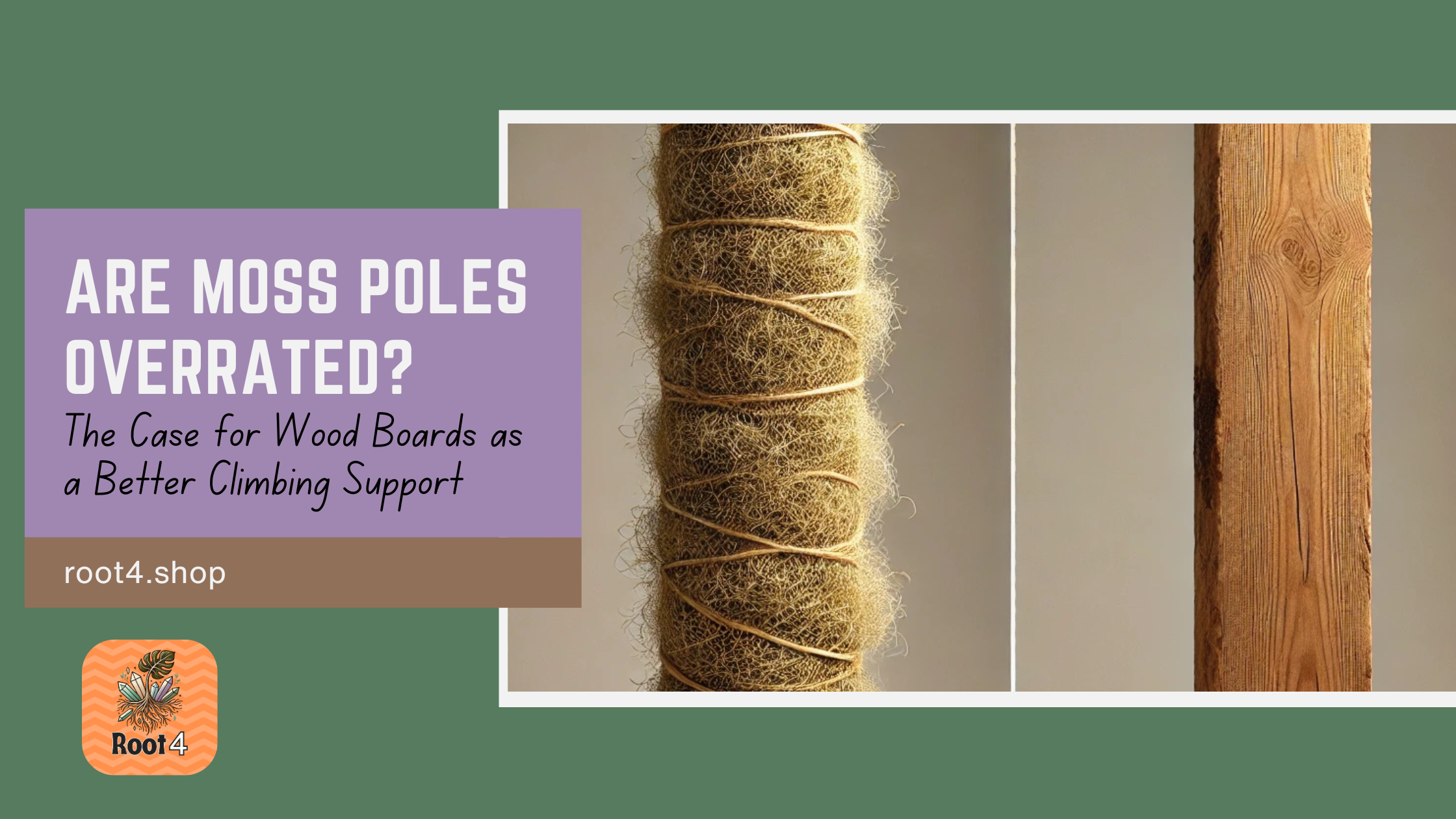Your cart is currently empty!

Are Moss Poles Overrated? The Case for Wood Boards as a Better Climbing Support
In the houseplant community, moss poles have become a staple for climbing plants like Monstera, Philodendron, and Pothos. Social media is flooded with tutorials on how to keep them moist, maintain humidity, and train plants to climb them. But what if moss poles aren’t actually the best option? What if they’re just another plant care trend that’s impractical for many plant owners?
I’ve struggled with moss poles for years—soaking them, misting them, and trying to keep them damp to encourage aerial root attachment. But no matter what I did, they would always dry out too quickly, especially in indoor conditions. The maintenance was overwhelming, and instead of benefiting my plants, it just became an additional stressor.
Then, I tried something different: a rough wood board. And in just one week, my Monstera deliciosa had already started anchoring its aerial roots, with no extra effort required. That’s when I started to question whether moss poles were actually the superior option or just another product being hyped by influencers.
The Problem with Moss Poles
I even experienced this firsthand with my own plants. My Monstera adansonii was on a moss pole that dried out, and despite my attempts, it became useless for root attachment. At one point, I tried to attach my Scindapsus pictus (Satin Pothos) to the same pole, but it refused to latch onto it. Instead, it decided to grow up my drywall—and to my surprise, it embedded itself into my dining room wall and started producing its largest leaves yet. This made me realize that many plants will naturally seek out the best surface for their needs, and a dry moss pole just doesn’t cut it.
Moss poles are designed to mimic the natural climbing surfaces that epiphytic plants encounter in the wild. However, their effectiveness is often overstated for the following reasons:
- They Dry Out Too Quickly – Unless you’re keeping your moss pole consistently moist (which requires frequent misting or wicking setups), it will dry out. Once dry, it loses its function as a root-friendly climbing surface and may even wick moisture away from aerial roots. Worse, rewetting a dry moss pole is nearly impossible, as sphagnum moss tends to repel water once it has completely dried.
- They Require High Maintenance – Regular soaking and misting are necessary to keep moss poles effective. Many plant parents, especially those who struggle with consistent watering, find this upkeep unrealistic.
- They Are Not Found in Nature – Climbing plants in the wild do not attach to wet sphagnum moss poles. Instead, they climb rough, textured tree bark that provides a sturdy grip and natural moisture retention.
- They Can Lead to Neglect – Many plant owners (myself included) end up neglecting their moss poles once they realize how much effort they require. A dry, neglected moss pole becomes useless and can even create a false sense of security in plant care.
Are There Any Situations Where Moss Poles Work Better?
While moss poles may not be the best option for every plant owner, there are certain cases where they might be beneficial—but only if they are kept consistently moist.
1. High-Humidity Greenhouse or Terrarium Setups
Moss poles perform better in enclosed, high-humidity environments where they remain damp naturally. In a greenhouse or terrarium, the moisture retention properties of moss can be beneficial.
2. Self-Watering or Wicking Systems
For plant owners who are dedicated to maintaining a moss pole’s moisture, setting up a wicking system or attaching a water reservoir can help keep the moss pole damp. This is one of the few ways to ensure the pole remains useful for aerial roots.
3. Tropical Plants That Naturally Encounter Mossy Surfaces
Some rainforest plants, such as certain Philodendron and Anthurium species, occasionally grow along or climb moss-covered surfaces in their natural habitat. However, even in these environments, they primarily attach to bark and other rough structures.
4. Encouraging Large Leaf Development
There is anecdotal evidence suggesting that some climbing plants, like Monstera, may develop larger leaves when aerial roots absorb additional moisture from a moss pole. However, this effect is only present if the moss pole stays consistently wet, which is a challenge in most indoor conditions.
5. Creeping or Shingling Plants May Prefer a Moss Surface (But Not a Pole)
Some creeping or shingling plants, such as Rhaphidophora cryptantha, Scindapsus, and Philodendron gloriosum, naturally grow along the forest floor or climb up tree trunks in humid environments. These plants may benefit from a moist moss mat or horizontal moss slab rather than a pole. A moss-covered surface can provide the humidity and texture they seek, but a vertical pole is unnecessary unless the plant is actively climbing.
If you’re considering a moss pole, be mindful that once it dries out, it becomes extremely difficult to rewet—making it an impractical choice unless you are committed to high-maintenance plant care.
Wood vs. Moss: A Quick Guide for Tropical Plants
Here’s a general guide on whether a wood board or a moss surface (mat/slab) is the better choice for common tropical plants:
- Monstera deliciosa – Wood board (better mimics tree bark and supports aerial roots)
- Monstera adansonii – Wood board (similar reasoning to deliciosa)
- Philodendron gloriosum – Moss mat/slab (a creeping plant that benefits from humidity but does not climb)
- Philodendron micans – Wood board (grows better with a stable, dry surface)
- Scindapsus pictus (Satin Pothos) – Moss mat/slab (slow creeper that may benefit from moisture but doesn’t require a pole)
- Rhaphidophora cryptantha – Moss mat/slab (shingling plant that prefers a damp surface but not a pole)
- Epipremnum aureum (Pothos) – Wood board (fast climber that grips rough surfaces well)
- Anthurium veitchii – Moss pole (can benefit from extra humidity and vertical growth support)
Why a Wood Board Is a Better Alternative
Wood boards offer a more natural, low-maintenance alternative that closely mimics the climbing conditions found in nature. Here’s why they work better:
1. Encourages Natural Climbing
Tree bark is what Monstera, Philodendrons, and similar plants actually climb in the wild. A rough, untreated wood board provides a similar texture, allowing aerial roots to grip and attach with ease.
2. Low Maintenance
Unlike moss poles, a wood board does not need to be misted, soaked, or maintained in any special way. It simply acts as a stable support for the plant to climb, reducing the time and effort required for upkeep.
3. More Reliable Root Attachment
Aerial roots will naturally seek out a solid, textured surface to cling to. In my personal experience, my Monstera started attaching to a wood board within one week—something I never achieved with a moss pole despite months of effort.
4. Ideal for Underwaterers and Dry Climates
If you struggle with keeping moss poles moist or live in a dry climate, a wood board is a much better option. It provides stability without requiring any additional watering or maintenance.
5. Sustainable and Cost-Effective
Instead of purchasing moss poles, you can repurpose an untreated wood board, which is often more affordable and sustainable. Many plant owners already have suitable materials lying around, making it an accessible alternative.
Final Thoughts: Are Moss Poles Just a Trend?
Moss poles have their place in plant care, but they’re not the universal solution they’re often made out to be. For many plant owners—especially those who struggle with keeping them moist or live in dry climates—a wood board is a better, more natural, and low-maintenance alternative.
I believe it’s time we rethink our approach to plant climbing supports. Have you tried using a wood board instead of a moss pole? I’d love to hear your thoughts!

Leave a Reply